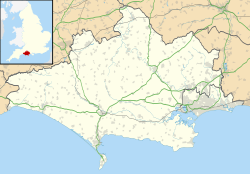RNAS Portland (HMS Osprey)
| RNAS Portland (HMS Osprey) | |||||||
|---|---|---|---|---|---|---|---|
| Near Portland, Dorset in England | |||||||
|
Shown within Dorset
|
|||||||
| Coordinates | 50°34′08″N 002°27′02″W / 50.56889°N 2.45056°WCoordinates: 50°34′08″N 002°27′02″W / 50.56889°N 2.45056°W | ||||||
| Type | Royal Naval Air Station | ||||||
| Site information | |||||||
| Owner | Ministry of Defence | ||||||
| Operator | Royal Navy | ||||||
| Site history | |||||||
| Built | 1917 | ||||||
| In use | 1917–1999 | ||||||
| Airfield information | |||||||
| Elevation | 1 metre (3 ft 3 in) AMSL | ||||||
|
|||||||
RNAS Portland (ICAO: EGDP) was an air station of the Royal Navy, situated at the Isle of Portland, Dorset, England. It was established in 1917 on the western edge of Portland Harbour as HMS Sarepta. From 1959 the station shared the name HMS Osprey with the anti-submarine establishment located at East Weares, which used the air station's helicopters for research and development in anti-submarine techniques. The establishment operated at Portland between 1924 and 1941, and was recommissioned there in 1946. HMS Osprey and RNAS Portland remained operational until they closed in 1999.
The original seaplane base was first built during World War I, in 1916, as HMS Sarepta. The station used floatplanes, and these flew coastal patrols to protect shipping from German U-boat attacks. In August 1918 HMS Sarepta was taken over by the RAF, and a larger unit of 12 aircraft was formed as No. 241 Squadron RAF. Following the Armistice in November 1918, No. 241 Squadron RAF was disbanded and aviation operations ceased by June 1919.
In September 1939, 772 Squadron, a Fleet Requirements Unit, arrived at Portland and stayed until July 1940. After the inactive inter-war period the base once again became an active flying station. With the fall of France early in the war, the Naval Base at Portland became a prime target for the Luftwaffe. As a result, the continued presence of Portland's anti-submarine school was unfeasible. The school moved to Cambeltown in July 1940, and took 772 Squadron with it. Therefore, Portland's base was held under Care and Maintenance and did not participate on active operations.
After the war the anti-submarine school returned to Portland and a helicopter base became an important centre for the school to perform experiments and development. In 1946 Sikorsky R-4Bs moved in, and the helicopters paved the way for the use of helicopters in the fleet. The success with these trials led the Admiralty to replace fixed-wing aircraft with helicopters, heralding a major building programme at Portland. The base's playing fields were soon taken over as a landing ground and the site became a modern heliport. The old fleet canteen was converted into the headquarters building, operations centre, workshop and control tower.
During the late 1950s the marshy area known as the Mere was filled in and built over, and later expansion meant that this tidal lagoon was completely covered. This created a large concreted area to produce the modern, large helicopter facility. Upon the completion of the work, 815 Naval Air Squadron flew its 12 Westland Whirlwinds to the new Portland Heliport on 14 April 1959. The station was formally commissioned as HMS Osprey on 24 April 1959.
...
Wikipedia

